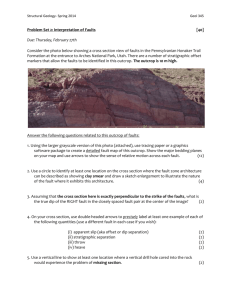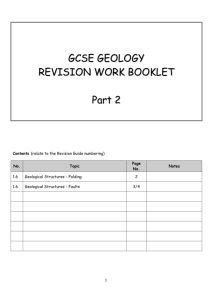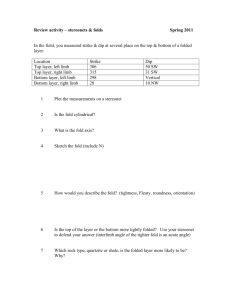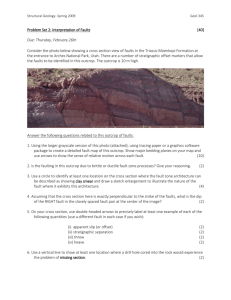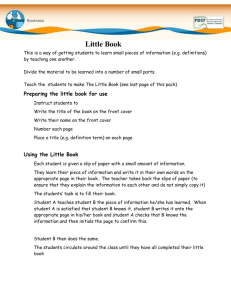Test 1 answers
advertisement
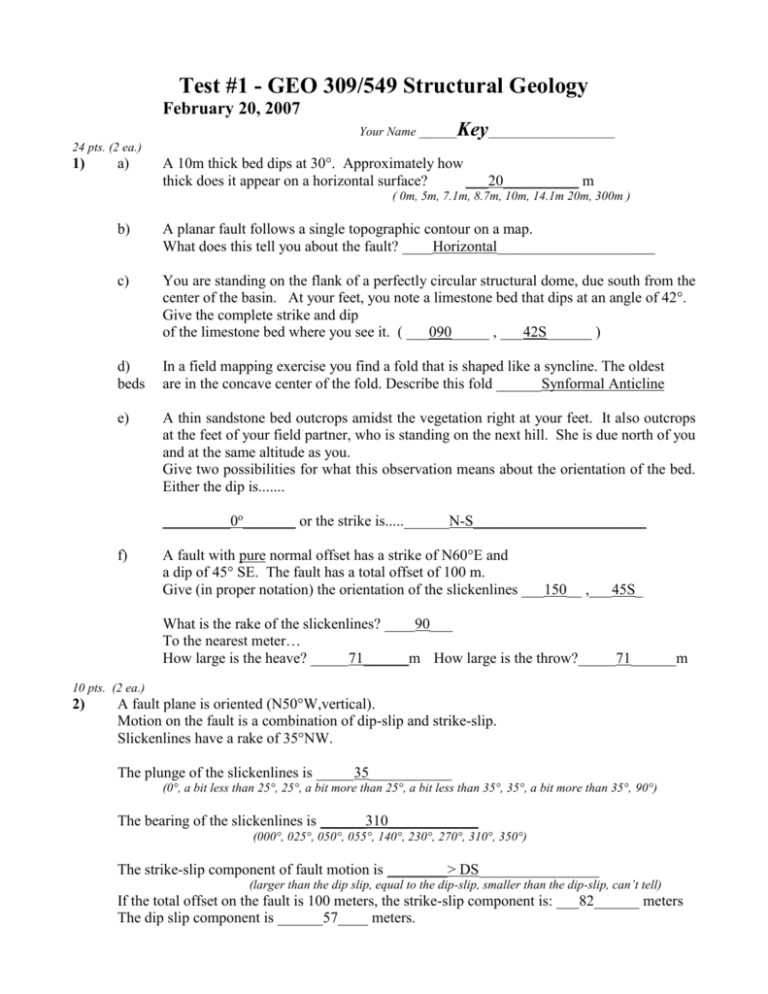
Test #1 - GEO 309/549 Structural Geology February 20, 2007 Your Name ______ Key____________________ 24 pts. (2 ea.) 1) a) A 10m thick bed dips at 30°. Approximately how thick does it appear on a horizontal surface? ___20__________ m ( 0m, 5m, 7.1m, 8.7m, 10m, 14.1m 20m, 300m ) b) A planar fault follows a single topographic contour on a map. What does this tell you about the fault? ____Horizontal_____________________ c) You are standing on the flank of a perfectly circular structural dome, due south from the center of the basin. At your feet, you note a limestone bed that dips at an angle of 42°. Give the complete strike and dip of the limestone bed where you see it. ( ___090_____ , ___42S______ ) d) beds In a field mapping exercise you find a fold that is shaped like a syncline. The oldest are in the concave center of the fold. Describe this fold ______Synformal Anticline e) A thin sandstone bed outcrops amidst the vegetation right at your feet. It also outcrops at the feet of your field partner, who is standing on the next hill. She is due north of you and at the same altitude as you. Give two possibilities for what this observation means about the orientation of the bed. Either the dip is....... _________0o_______ or the strike is.....______N-S_______________________ f) A fault with pure normal offset has a strike of N60°E and a dip of 45° SE. The fault has a total offset of 100 m. Give (in proper notation) the orientation of the slickenlines ___150__ ,___45S_ What is the rake of the slickenlines? ____90___ To the nearest meter… How large is the heave? _____71______m How large is the throw?_____71______m 10 pts. (2 ea.) 2) A fault plane is oriented (N50°W,vertical). Motion on the fault is a combination of dip-slip and strike-slip. Slickenlines have a rake of 35°NW. The plunge of the slickenlines is _____35___________ (0°, a bit less than 25°, 25°, a bit more than 25°, a bit less than 35°, 35°, a bit more than 35°, 90°) The bearing of the slickenlines is ______310____________ (000°, 025°, 050°, 055°, 140°, 230°, 270°, 310°, 350°) The strike-slip component of fault motion is ________> DS________________ (larger than the dip slip, equal to the dip-slip, smaller than the dip-slip, can’t tell) If the total offset on the fault is 100 meters, the strike-slip component is: ___82______ meters The dip slip component is ______57____ meters. 16 pts. 3) cos sin Using a rotation tensor of R , a vector with a starting orientation of x=1, sin cos y=0 is rotated by 45° counterclockwise. This vector has a new orientation of x=___0.71 y=__0.71__. The plates on the earth are rigid spherical caps and their respective motions can be described by axes of _Rotation that pass through the _Center__ of the Earth. The transform faults at mid-ocean ridges define _______ _________, or lines of latitude about the pole of rotation. In a 3-D case, there are __3___ principal axes of strain. A principal axis of strain can be thought of as a direction along which the starting vector and ending vector are in (a) the same direction (b) differing directions (c) a ninety degree orientation from one another (d) an angular separation of one radian. ____A___ 18 pts. (2 ea, plus 2 for work shown on map) 4) Below is a topographic map (elevations in meters), showing the trace of a limestone bed across the surface of a hill. There is a fold. (You MAY note TWO possible solution. Choose the solution where the strikes of the beds on the limbs of the folds are more N-S oriented (as opposed to E-W oriented) What (within 15° each) are the strike and dip of the bed on one side of the fold? _000_____, ____45E__ ..............and on the other side of the fold they are: ___180__, ____45W__ If we define the fold axis as the line separating the two dip domains, then what (within 15° each) are the bearing and plunge of the fold axis? __000____, ___000___ Look at the strike lines you drew. The fold could have been produced by (a) east-west extension (b) east-west compression (c) N-S compression (d) N-S extension (e) strike-slip deformation ___B___ SHOW ALL YOUR WORK ON THE MAP, and INDICATE THE FOLD AXIS 600 500 400 300 200 100 0 200 400 scale in meters 600 16 pts. (2 ea.) 5) In an area with very little topography, a fold plunges at a SHALLOW angle. All beds dip at only shallow angles. In the fold is a bed that appears as a thick black curve on the map below. There is also a vertical dike that appears as a shaded line striking northwest-southeast. The bed and the dike are both cut by an east-west striking fault that dips STEEPLY. Beds are NOT overturned. Is the fold a syncline or an anticline? ___Anticline____. Which way does it plunge? ___E___ (N,E,S,W) If the fault is strike-slip, it is __Right_-lateral. Now, look carefully at how the bed has been offset vertically.......... If the fault is a normal fault, then which side has dropped downward? The ____North_____ side. ( north , south ) Therefore, if it is a normal fault, which way does the fault dip? ____North_____ ( north , south ) EXPLAIN below in A FEW WORDS the best clue that it’s a normal (and not strike-slip) fault: ____________________________________________________________________________ Where are the rocks older at the surface, X or Y? ___Y_______ Where will you find the bed if you drill vertically? _______X______________ ( X , Y , X and Y , neither X nor Y ) 16 pts. 6) For an exposed section of the San Andreas Fault, one would expect to see slickenlines that have a rake of _________0_____(0°, 30°, 45°, 90°, 130°). The plunge on these slickenlines are expected to be _______0________(0°, 30°, 45°, 90°, 130°) The forces that give rise to the significant permanent strains (deformation) with the Earth’s crust arise from: (a) lunar tides (b) relative plate motions (c) solar wind (d) centrifugal force (e) ocean and glacial loading. Cross-sections are usually ___Perpendicular__ to strike, so as to show ___True____ dips. If one observes flat beds on a vertical cliff face, then either the beds are ___Flat_____ or the direction perpendicular to the cliff face is the direction of __True___ _____Dip___. Apparent dip is always _____< or =_______ true dip. Moreover, the plunge of a slip vector is always ___< or =__________ the rake of the slip vector. (greater than, less than, greater than or equal to, less than or equal to )

